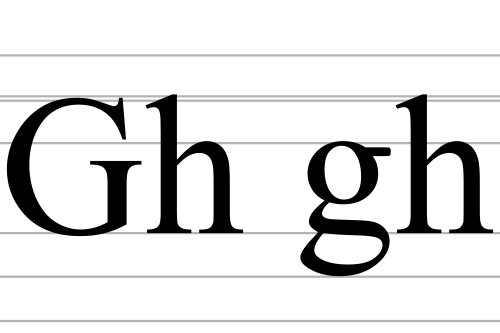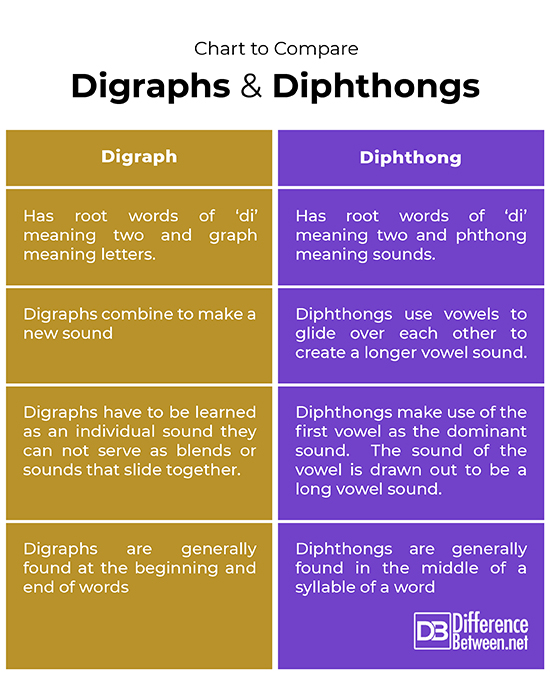Difference Between Diphthong and Digraph
Diphthongs and digraphs are well represented in the world of words and sounds. They are ways of explaining how sounds are made and what combination of letters make these sounds. The sounds chosen are from the English alphabet of 26 letters made up of vowels and consonants. Five simple vowels make up the vowel sounds of a,e,i,o, and u. In terms of sounds the letter y can sound like a vowel because of its ability to sound like an i or an e. For the purposes of diphthongs the letters a,e,i,o,u are the significant ones. Digraphs are made up of consonants only or consonants and vowels. Consonants and vowels are combined to become one single sound. Knowledge of the single sound values of the letters changes as the combinations of letters take on a new sound. The root portion of the words, ‘di’ found at the beginning of each word, represents the fact that there are two letters used to make the new sound.

Definition of a Digraph
Digraphs are sounds made of two letters. Once these two letters are combined they make one sound used phonetically to make up words. Not the whole word, but an initial or final part of a word. It is a sound that is not like the individual sound of the two letters combined to produce that sound. You can not make the sound of each letter to sound out the word. You have to know what they make as a combined sound. Digraphs should not be confused with blends of letters where two letters ‘slide’ together in a sound. A blend can be broken into its two single parts like s and l together can be the sl sound of slide, but sh the sh of shut is one distinctive sound with the two letters that make it combining, not blending together. An initial digraph comes at the beginning of a word and a final digraph at the end of a word. Sh, ch, wh, th and many others are typical digraphs using consonant sounds to make the digraph. The ph at the end of the word digraph is in fact a digraph. The ph letters combine to make the sound of letter f.
Different types of digraphs
The most common digraphs are ch, sh, wh and th. Most teachers tackle these first. There are other consonant digraphs less common. Vowel digraphs are a combination of a vowel and a consonant. There are ar sounds, or and er and other combinations that create new sounds with their letters together. Learning these sounds as groups of words make it easier to remember them. This gives the learner a guideline of letter combinations and principles to use to decipher sounds and words phonetically.

Definition of a Diphthong
A diphthong is a combination of two vowels that join together to make one vowel sound known as a long vowel sound. The first of the two vowels in the combination takes on the duty of producing the sound. This method of moving from one vowel to another and producing one long vowel sound is known as gliding. The sound of the first vowel glides over the second making the second vowel silent. These vowels are also known as compound vowels or complex vowels. The word diphthong comes from Greek origins, meaning two voices or two sounds. There is a noticeable sound change from the two single vowels into the one longer vowel sound. This sound change is known as dipthongization. There is debate about the number of diphthongs in the English language, but it is generally thought that a diphthong should have ‘moving vowels’ to be called a diphthong. This means the sound of one travels over the other to encompass them both into one sound. It is interesting to see how dialects can affect the sounds heard in different diphthongs. The word dog can sometimes be heard as ‘dawg’ instead of dog. It is just the accent that affects the sound of the word.
Different types of Diphthong
There are several classifications of diphthongs. Some are called wide diphthongs or open diphthongs and they have a wider movement from an open vowel to a closed sound or letter. The combination of ow for example. Say the sound and you will feel your mouth move from a wide open shape to a closed pursed lips shape. Narrow diphthongs have less movement. Like the sound ay as in day. Say day and you will feel how your mouth responds to the ay sound. Rising diphthongs are the ones that sound as if the second part of the sound is more important. For example view, the ‘oo’ sound heard at the end of the word, is more dominant. Falling diphthongs are the ones in which the first part sounds more important. Some diphthongs are classified by the movement of the tongue. As you can see this is all quite complicated and once again learning the sounds in groups makes it easier for remembering and recognising the sounds and the way to spell the words in each group.
How do root words help with understanding diphthongs and digraphs?
Understanding the root behind a word helps to give the background to the word and to transfer that knowledge onto other words in similar word groups. In studying digraphs and diphthongs both words have a common root at the beginning and that is di. This root word, meaning two means these words have two of something. The root of phon meaning sound or phthong. Phon, meaning sound, is used more often in words like phonetic or phonological. This tells us that a diphthong is a word with a sound that has two parts.
Graph is the root word meaning letters or writing. A digraph then is a sound made with two letters making a single letter sound. There are consonant digraphs or vowel digraphs. A split diphthong occurs when a consonant comes between two vowels. This is often known as the magic e sound to help children with this concept. A vowel becomes long in its sound as the e on the end is silent and a consonant comes between the vowels.
How to teach Digraphs and Diphthongs.
When you start to teach digraphs it is important to distinguish between digraphs and blends. In each of the sound combinations two letters are used, but the blend just blends the two sounds together, while the digraph changes the two letters to a different sound. Practice makes perfect in the case of learning sounds and language. Using letter cards and word matching and sound matching games help children or ESL, English as a second language, learners to hear the sounds and begin to group them as sounds together.
Diphthongs are vowel sounds that are combined to make a single sound or a gliding vowel sound. Two vowels together are taught as teams and learned in ways that help encourage hearing the sounds together.
Chart to compare Digraphs and Diphthongs:

Summary of the difference between Digraph and Diphthong.
- The meaning of these two words centres on sound combinations.
- Digraphs and diphthongs are combinations of two letters and the root di indicates that fact.
- The main difference is the digraph is focused on two letters either a vowel and consonant or two consonants. A diphthong is focused on two vowels and depends on a vowel sound change through looking at the first vowel in the combination.
- Digraphs generally occur at the beginning or end of a word. Occasionally at the beginning and end of a word ie church. Diphthongs are found in the middle of a syllable or in the case of a split diphthong a consonant comes between the vowels and makes the second vowel silent. For example hat become hate and the vowel a becomes a long sound.
- Learning these sounds and their combinations is helped by grouping them together into what is known as teams.
- Learning the language depends on knowing the sounds and practising them in lists called teams.
- Difference Between Lagoon and Bay - October 20, 2021
- Difference Between Futurism and Preterism - August 12, 2021
- Difference Between Dichotomy and Paradox - August 7, 2021
Search DifferenceBetween.net :
Leave a Response
References :
[0]Www.educatingalpacas.com Carolane Sue. 2020/02/03. Digraphs vs Diphthongs. pub.Christopher Couch wordpress.
[1]Www.factsumo.com.blob. Bense Brendon. 2019/04/11. Digraphs and Diphthongs. Pub. FactSumo.
[2]Www.thriveedservices.com. Orpi Delilah. 2020/12/31. All about the Vowel team syllable (vowel digraphs and Diphthongs) pub. Charlotte on Genesis.
[3]Image credit: https://upload.wikimedia.org/wikipedia/commons/thumb/6/63/Latin_digraph_G_H.svg/500px-Latin_digraph_G_H.svg.png
[4]Image credit: https://upload.wikimedia.org/wikipedia/commons/thumb/d/da/RP_English_diphthongs_chart.svg/500px-RP_English_diphthongs_chart.svg.png
